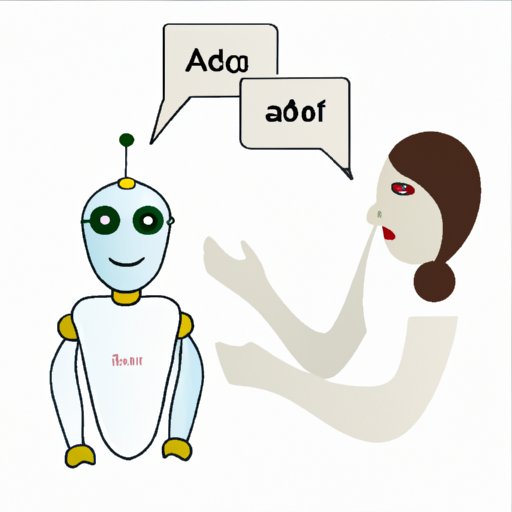Introduction
Robots have been a common presence in science fiction for decades, but they are now becoming more of a reality than ever before. With the help of advanced technology, robots are being used in all areas of life, from healthcare and manufacturing to entertainment and customer service. But what do robots say? How do they communicate? This article will explore the language of robotics and the implications of this technology.
Exploring the Language of Robots: What Do They Say?
Robot communication is based on a combination of programming and artificial intelligence (AI). Most robots are programmed with a set of predetermined phrases that are triggered by certain user commands or environmental conditions. For example, when a robot is asked a question, it may respond with an answer that has been programmed into its memory. As robots become increasingly sophisticated, their language capabilities are also evolving.
Recent advancements in AI have enabled robots to learn and understand language more effectively. According to research published in the journal IEEE Transactions on Cognitive and Developmental Systems, robots can be trained to use natural language processing (NLP) to interpret human instructions. This means that robots can now understand complex sentences and respond appropriately.
In addition, AI-driven robots are capable of engaging in conversations with humans. For example, some robots can recognize facial expressions, remember conversations, and even detect emotions. This allows them to respond to users in more meaningful ways.

The Power of Artificial Intelligence in Robot Speech
AI is playing an increasingly important role in the development of robots. By leveraging machine learning algorithms, robots can learn from data and gradually improve their language capabilities. This has enabled robots to understand and respond to spoken language more accurately.
AI-driven robots can also use natural language processing (NLP) to interpret user commands and provide feedback. This allows robots to respond to questions and requests in more human-like ways. Additionally, AI-powered robots can engage in more complex conversations and interact with users on a deeper level.
What is the Future of Human-Robot Interaction?
As robots become increasingly sophisticated, the possibilities for human-robot interaction are limitless. Conversational technologies such as natural language processing (NLP) can enable robots to understand human instructions and respond accordingly. This can dramatically improve customer service experiences, as well as enhance user experience through natural language processing.
However, there are still some challenges posed by human-robot interaction. For example, robots may not be able to fully comprehend the nuances of human conversation, making it difficult for them to interact in a meaningful way. Additionally, robots may not be able to interpret user sentiment accurately, resulting in misunderstandings or incorrect responses.

Deciphering the Meaning Behind Robot Utterances
Interpreting robot dialogue can be difficult, as robots often speak in a limited vocabulary. However, there are techniques that can be used to decipher the meaning behind robot utterances. For example, analyzing the context of a conversation can help identify the intended meaning of a robot’s statements.
In addition, analyzing robot sentiment in conversations can help determine the emotional state of a robot. This can provide valuable insight into how a robot is feeling and how it is likely to respond to a particular situation.
Investigating the Benefits of Robot Conversational Technologies
Robotic conversational technologies have the potential to revolutionize customer service experiences. By leveraging natural language processing (NLP), robots can understand human commands and provide accurate responses. This can significantly reduce the time it takes to complete customer requests and improve customer satisfaction.
Additionally, robots can be used to enhance user experience. For example, robots can provide personalized recommendations and advice based on user preferences. This can lead to increased engagement and improved user satisfaction.
Conclusion
Robots are rapidly becoming more intelligent and capable of understanding and responding to human language. This has enabled robots to engage in conversations and interact with humans in more meaningful ways. While there are still some challenges posed by human-robot interaction, advances in AI and natural language processing (NLP) can help robots understand and respond to user instructions more accurately. In addition, robots can provide valuable customer service experiences and enhance user experience through natural language processing.
(Note: Is this article not meeting your expectations? Do you have knowledge or insights to share? Unlock new opportunities and expand your reach by joining our authors team. Click Registration to join us and share your expertise with our readers.)
